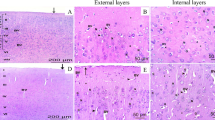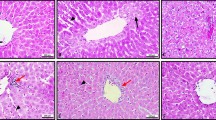Abstract
The aim of this study was to determine possible protective influences of selenium (Se), N-acetylcysteine (NAC), and vitamin E (Vit E) against acute ethanol (EtOH) intoxication. Thirty-six rats were divided into six groups: I (control), II (EtOH), III (EtOH + Se), IV (EtOH + Vit E), V (EtOH + NAC), and VI (EtOH + mix). Except group I, EtOH was given the other pretreated (groups III, IV, V, and VI) and untreated groups (group II). Compared with the EtOH group, serum aspartate aminotransferase, alanine aminotransferase, alkaline phosphatase, lactate dehydrogenase, creatine kinase, and creatine kinase-MB levels were significantly decreased in all pretreated groups, whereas slightly diminished amylase and lipase were observed. Compared with the control group, a remarkably lower total antioxidant status (TAS), but higher total oxidant status (TOS), and oxidative stress index (OSI) were seen in brain, liver, and kidney tissues. The values of these parameters were less affected from EtOH-exposed brain tissue of EtOH + NAC and liver of EtOH + mix groups. Both significant decrease of catalase activity and marked increases of adenosine deaminase and myeloperoxidase were determined only in liver tissue of the EtOH group. Activities of these enzymes were restored in almost all pretreated groups. Moreover, an increase of xanthine oxidase activity was prevented in brain tissue of pretreated groups. In histopathological examination of the liver, hydropic degeneration, sinusoidal dilatation, mononuclear cell infiltration, and marked congestion, which were seen in the EtOH group, were prevented in all pretreated groups. Relative protection against acute EtOH toxicity, in both single and combined pretreatments of Se, NAC, and Vit E supplementation, was probably through antioxidant and free radical-neutralizing effects of foregoing materials.



Similar content being viewed by others
References
Lieber CS (1995) Medical disorders of alcoholism. N Engl J Med 333:1058–1065
Kanbak G, Inal M, Baycu C (2001) Ethanol-induced hepatotoxicity and protective effect of betaine. Cell Biochem Funct 19:281–285
Polavarapu R, Spitz DR, Sim JE, et al. (1998) Increased lipid peroxidation and impaired antioxidant enzyme function is associated with pathological liver injury in experimental alcoholic liver disease in rats fed diets high in corn oil, and fish oil. Hepatology 27:1317–1323
Schlorff EC, Husain K, Somani SM (1999) Dose- and time-dependent effects of ethanol on plasma antioxidant system in rat. Alcohol 17:97–105
Adachi M, Ishii H (2002) Role of mitochondria in alcoholic liver injury. Free Radic Biol Med 32:487–491
Tuma DJ (2002) Role of malondialdehyde-acetaldehyde adducts in liver injury. Free Radic Biol Med 32:303–308
Zima T, Fialova L, Mestek O, et al. (2001) Oxidative stress, metabolism of ethanol and alcohol-related diseases. J Biomed Sci 8:59–70
Zondervan KT, Ocke MC, Smit HA, et al. (1996) Do dietary and supplementary intakes of antioxidants differ with smoking status? Int J Epidemiol 25:70–79
Lieber CS, Csini A, DeCarli LM, et al. (1990) S-Adenosyl-Lmethionine attenuates alcohol-induced liver injury in the baboon. Hepatology 11:165–172
Navasumrit P, Ward TH, Dodd NCF, et al. (2000) Ethanol-induced free radicals and hepatic DNA strand breaks are prevented in vivo by antioxidants: effects of acute and chronic ethanol exposure. Carcinogenesis 21:93–99
El-Naga RN (2015) Apocynin protects against ethanol-induced gastric ulcer in rats by attenuating the upregulation of NADPH oxidases 1 and 4. Chem Biol Interact 242:317–326
Warren S, Patel S, Kapron CM (2000) The effect of vitamin E exposure on cadmium toxicity in mouse embryo in vitro. Toxicology 142:119–126
Schrauzer GN (2000) Anticarcinogenic effect of selenium. Cell Mol Life Sci 57:1864–1873
Yan SL, Yin MC (2007) Protective and alleviative effects from 4 cysteine-containing compounds on ethanol-induced acute liver injury through suppression of oxidation and inflammation. J Food Sci 72(7):511–515
Fernandez-Checa JC, Hirano T, Tsukamoto H, et al. (1993) Mitochondrial glutathione depletion in alcoholic liver disease. Alcohol 10:469–475
Lluis JM, Colell A, Garcia-Ruiz C, et al. (2003) Acetaldehyde impairs mitochondrial glutathione transport in HepG2 cells through endoplasmic reticulum stress. Gastroenterology 124:708–724
Ozdil S, Bolkent S, Yanardag R, et al. (2004) Protective effects of ascorbic acid, dl-alpha-tocopherol acetate, and sodium selenate on ethanol-induced liver damage of rats. Biol Trace Elem Res 97:149–162
Gencel O, Naziroglu M, Celik O, et al. (2010) Selenium and vitamin E modulates radiation-induced liver toxicity in pregnant and nonpregnant rat: effects of colemanite and hematite shielding. Biol Trace Elem Res 135(1–3):253–263
Sirmali M, Uz E, Sirmali R, et al. (2007) Protective effects of erdosteine and vitamins C and E combination on ischemia-reperfusion-induced lung oxidative stress and plasma copper and zinc levels in a rat hind limb model. Biol Trace Elem Res 118(1):43–52
Luo J, Tsuji T, Yasuda H, et al. (2008) The molecular mechanisms of the attenuation of cisplatin-induced acute renal failure by N-acetylcysteine in rats. Nephrol Dial Transplant 23(7):2198–2205
Enaida H, Sakamoto T, Hisatomi T, et al. (2002) Morphological and functional damage of the retina caused by intravitreous indocyanine green in rat eyes. Graefes Arch Clin Exp Ophthalmol 240:209–213
Erel O (2004) A novel automated direct measurement method for total antioxidant capacity using a new generation, more stable ABTS radical cation. Clin Biochem 37(4):277–285
Erel O (2005) A new automated colorimetric method for measuring total oxidant status. Clin Biochem 38(12):1103–1111
Ozkol HU, Koyuncu I, Tuluce Y, et al. (2015a) Anthocyanin-rich extract from Hibiscus sabdariffa calyx counteracts UVC-caused impairments in rats. Pharm Biol 53(10):1435–1441
Ozkol HU, Ozkol H, Karadag AS, et al. (2015b) Oral isotretinoin therapy of acne patients decreases serum paraoxonase-1 activity through increasing oxidative stress. Drug Chem Toxicol 38:63–66
Aebi H (1974) Catalase. In: Bergmeyer HU (ed) Methods of enzymatic analysis. Academic Press, New York, pp. 673–677
Giusti G (1974) Adenosine deaminase. In: Bergmeyer HU (ed) Methods of enzymatic analysis. Academic Press, New York, pp. 1092–1099
Bradley PP, Priebat DA, Christensen RD, et al. (1982) Measurement of cutaneous inflammation: estimation of neutrophil content with an enzyme marker. J Investig Dermatol 78:206–209
Prajda N, Weber G (1975) Malign transformation-linked imbalance: decreased XO activity in hepatomas. FEBS Lett 59:245–249
Albano E (2006) Alcohol, oxidative stress and free radical damage. Proc Nutr Soc 65:278–290
Zivković V, Miletić B, Nikolić S, et al. (2010) Sudden cardiac death and acute drunken state-autopsy study. Srp Arh Celok Lek 138(9–10):590–594
Dey A, Cederbaum AI (2006) Alcohol and oxidative liver injury. Hepatology 43:63–74
Dekanski D, Ristic S, Mitrovic D (2009) Antioxidant effect of dry olive (Olea europaea L.) leaf extract on ethanol-induced gastric lesions in rats. Mediterr J Nutr Metab 2:205–211
Ediz L, Ozkol H, Tekeoglu I, et al. (2011) Increased oxidative stress in patients with familial Mediterranean fever during attack period. Afr Health Sci 11(1):6–13
Tuluce Y, Ozkol H, Koyuncu I, et al. (2011) Gastroprotective effect of small centaury (Centaurium erythraea L) on aspirin-induced gastric damage in rats. Toxicol Ind Health 27(8):760–768
Ozkol H, Ediz L, Şekeroğlu R, et al. (2012a) Activities of cholinesterases, adenosine deaminase and myeloperoxidase in patients with familial Mediterranean fever. Turk J Phys Med Rehab 58:184–188
Kurdoglu Z, Ozkol H, Kurdoglu M (2012) Serum myeloperoxidase and adenosine deaminase activities in polycystic ovary syndrome. Gynecol Endocrinol 28(2):115–118
Hassoun EA, Stohs SJ (1995) Comparative studies on oxidative stress as a mechanism for the fetotoxic of TCDD, endrin and lindane in C57BL/6J and DBA/2J mice. Teratology 51:186–192
Navarro CM, Montilla PM, Martin A, et al. (1993) Free radicals scavenger and antihepatotoxic activity of Rosmarinus. Planta Med 59:312–314
Bati B, Celik I, Dogan A (2015) Determination of hepatoprotective and antioxidant role of walnuts against ethanol-induced oxidative stress in rats. Cell Biochem Biophys 71(2):1191–1198
Pourbakhsh H, Taghiabadi E, Abnous K, et al. (2014) Effect of Nigella sativa fixed oil on ethanol toxicity in rats. Iran J Basic Med Sci 17(12):1020–1031
Wu JP, Ho TJ, Tsai CC, et al. (2015) Hepatoprotective effects of traditional Chinese medicine on liver fibrosis from ethanol administration following partial hepatectomy. Chin J Physiol. doi:10.4077/CJP.2015.BAD339
Kartkaya K, Kanbak G, Oğlakçı A, et al. (2014) Protective effect of calpain inhibitor N-acetyl-L-leucyl-L-leucyl-L-norleucinal on acute alcohol consumption related cardiomyopathy. Mol Biol Rep 41(10):6743–6753
Ozkol H, Tuluce Y, Dilsiz N, et al. (2013) Therapeutic potential of some plant extracts used in Turkish traditional medicine on streptozocin-induced type 1 diabetes mellitus in rats. J Membr Biol 246(1):47–55
Bjomeboe A, Bjorneboe GE (1993) Antioxidant status and alcohol-related diseases. Alcohol Alcohol 28:111–116
Sonde V, D’souza A, Tarapore R, et al. (2000) Simultaneous administration of diethylphthalate and ethyl alcohol and its toxicity in male Sprague-Dawley rats. Toxicology 147:23–31
Celik I, Temur A, Isık I (2009) Hepatoprotective role and antioxidant capacity of pomegranate (Punica granatum L.) flowers infusion against trichloroacetic acid-exposed in rats. Food Chem Toxicol 47(1):145–149
Yan SL, Yang HT, Lee HL, et al. (2014) Protective effects of maslinic acid against alcohol-induced acute liver injury in mice. Food Chem Toxicol 74:149–155
Cao YW, Jiang Y, Zhang DY, et al. (2015) The hepatoprotective effect of aqueous extracts of Penthorum chinense Pursh against acute alcohol-induced liver injury is associated with ameliorating hepatic steatosis and reducing oxidative stress. Food Funct 6(5):1510–1517
Reddy VD, Padmavathi P, Kavitha G, et al. (2011) Emblica officinalis ameliorates alcohol-induced brain mitochondrial dysfunction in rats. J Med Food 14:62–68
Fadillioglu E, Yilmaz HR, Erdogan H, et al. (2003) The activities of tissue xanthine oxidase and adenosine deaminase and the levels of hydroxyproline and nitric oxide in rat hearts subjected to doxorubicin: protective effect of erdosteine. Toxicology 191:153–158
Varadinova MG, Valcheva-Traykova ML, Boyadjieva NI (2015) Effect of circadian rhythm disruption and alcohol on the oxidative stress level in rat brain. Am J Ther Epub ahead of print Nov 17
Ozkol H, Musa D, Tuluce Y, et al. (2012b) Ameliorative influence of Urtica dioica L against cisplatin-induced toxicity in mice bearing Ehrlich ascites carcinoma. Drug Chem Toxicol 35(3):251–257
Kalaz EB, Aydın AF, Doğan-Ekici I, et al. (2015) Protective effects of carnosine alone and together with alpha-tocopherol on lipopolysaccharide (LPS) plus ethanol-induced liver injury. Environ Toxicol Pharmacol 42:23–29
Kubes P, Jutila M, Payne D (1995) Therapeutic potential of inhibiting leukocyte rolling in ischemia/reperfusion. J Clin Invest 95(6):2510–2519
Taoka Y, Okajima K, Uchiba M, Murakami K, Kushimoto S, Johno M, Naruo M, Okabe H, Takatsuki K (1997) Role of neutrophils in spinal cord injury in the rat. Neuroscience 79(4):1177–1182
Author information
Authors and Affiliations
Corresponding author
Ethics declarations
All animals received humane care in compliance with the European community guidelines on the care and use of laboratory animals. This study was approved by the ethic committee of the Yuzuncu Yıl University (Decision number: 2015/12).
Conflict of Interest
The authors declare that they have no conflict of interest.
Rights and permissions
About this article
Cite this article
Ozkol, H., Bulut, G., Balahoroglu, R. et al. Protective Effects of Selenium, N-Acetylcysteine and Vitamin E Against Acute Ethanol Intoxication in Rats. Biol Trace Elem Res 175, 177–185 (2017). https://doi.org/10.1007/s12011-016-0762-8
Received:
Accepted:
Published:
Issue Date:
DOI: https://doi.org/10.1007/s12011-016-0762-8




